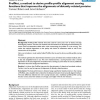Free Online Productivity Tools
i2Speak
i2Symbol
i2OCR
iTex2Img
iWeb2Print
iWeb2Shot
i2Type
iPdf2Split
iPdf2Merge
i2Bopomofo
i2Arabic
i2Style
i2Image
i2PDF
iLatex2Rtf
Sci2ools
BMCBI
2005
2005
ProfNet, a method to derive profile-profile alignment scoring functions that improves the alignments of distantly related protei
Background: Profile-profile methods have been used for some years now to detect and align homologous proteins. The best such methods use information from the background distribution of amino acids and substitution tables either when constructing the profiles or in the scoring. This makes the methods dependent on the quality and choice of substitution table as well as the construction of the profiles. Here, we introduce a novel method called ProfNet that is used to derive a profile-profile scoring function. The method optimizes the discrimination between scores of related and unrelated residues and it is fast and straightforward to use. This new method derives a scoring function that is mainly dependent on the actual alignment of residues from a training set, and it does not use any additional information about the background distribution. Results: It is shown that ProfNet improves the discrimination of related and unrelated residues. Further it can be used to improve the alignment of ...
| Added | 15 Dec 2010 |
| Updated | 15 Dec 2010 |
| Type | Journal |
| Year | 2005 |
| Where | BMCBI |
| Authors | Tomas Ohlson, Arne Elofsson |
Comments (0)

